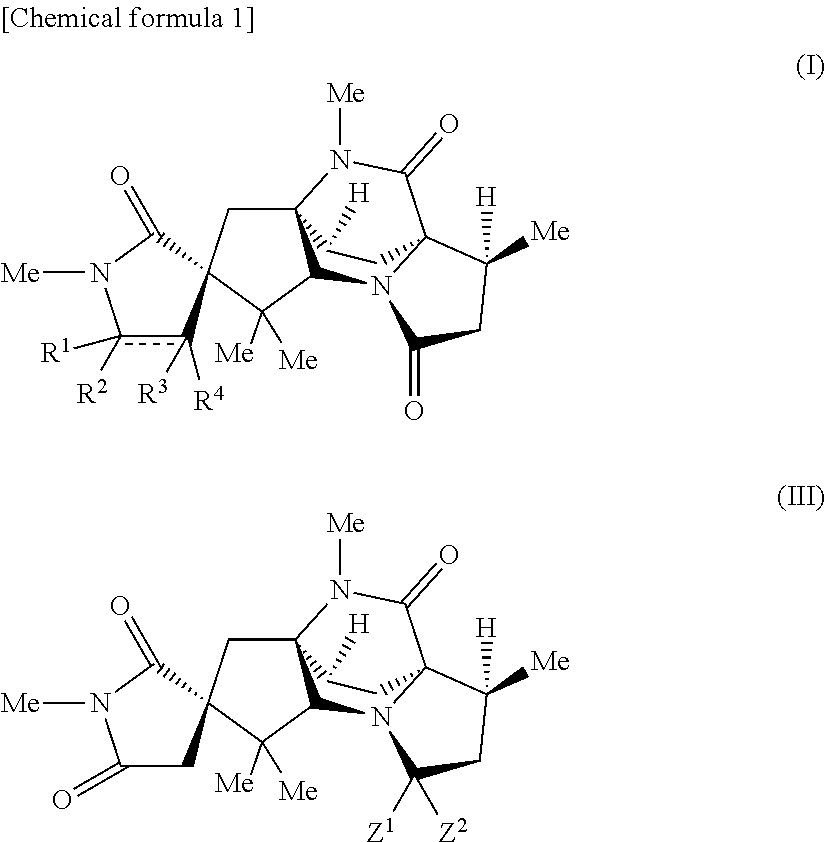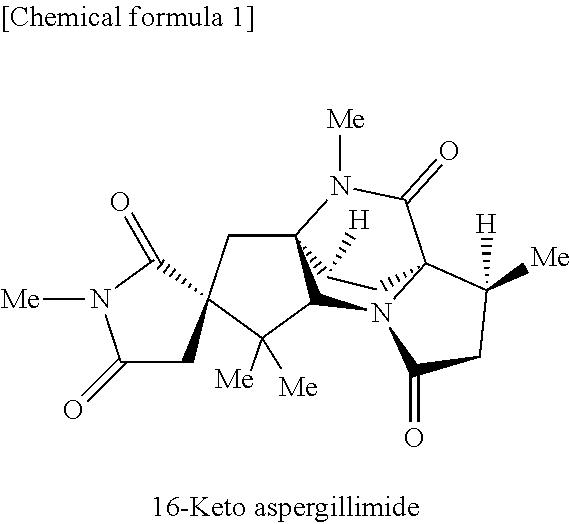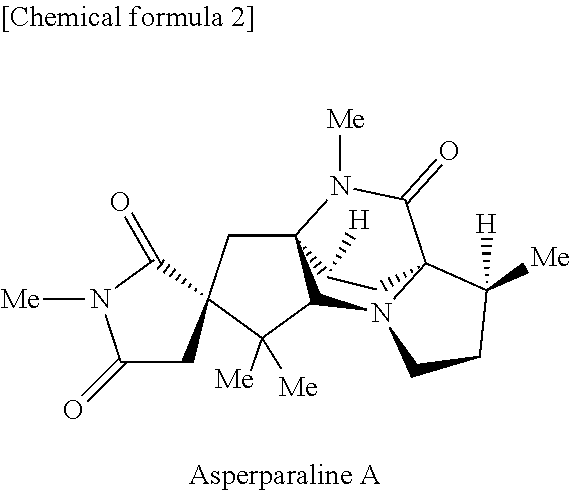16-keto aspergillimides and harmful organism control agent comprising the same as active ingredient
a technology of harmful organisms and active ingredients, which is applied in the direction of antiparasitic agents, biocides, drug compositions, etc., can solve the problems of no report about no report at all of the activity of this substance against ectoparasites, and interest in novel derivatives, etc., to achieve potent ectoparasiticidal effect, high safety, and high safety
- Summary
- Abstract
- Description
- Claims
- Application Information
AI Technical Summary
Benefits of technology
Problems solved by technology
Method used
Image
Examples
examples
[0141]The present invention is further illustrated by the following Examples that are not intended as a limitation of the invention.
synthesis examples
Synthesis Example 1
Compound 1
[0142]
[0143]16-Keto aspergillimide (50 mg) was dissolved in 1.0 ml of THF, and 1.0 ml of methanol was added to the solution. NaBH4 (25 mg) was added thereto, and the mixture was stirred at room temperature for one min. Further, 25 mg of NaBH4 was added, and the disappearance of the starting material was confirmed. An aqueous ammonium chloride solution was added to the reaction solution, and the mixture was extracted with chloroform. The extract was dried over anhydrous sodium sulfate, and the solvent was removed by evaporation under the reduced pressure. The crude compound thus obtained was subjected to preparative TLC (CHCl3:MeOH=10:1) to give compound 1 (40 mg, 80%).
[0144]1H NMR(CDCl3) 0.93 (3H, s), 0.95 (3H, s), 1.45 (3H, d, J=6.5 Hz), 1.45 (1H, m), 1.53 (1H, d, J=6.5 Hz), 2.04-2.16 (2H, m), 2.20-2.32 (2H, m), 2.43 (1H, dd,J=7.5, 16.0 Hz), 2.66 (1H, d, J=15.0 Hz), 2.76(1H, d, J=16.5 Hz), 2.80 (3H,s), 2.87 (3H, s), 2.93 (1H, br t, J=9.5 Hz), 3.26(1H, d...
synthesis example 2
Compound 2 (1:4)
[0146]
[0147]Compound 1 (15.0 mg) obtained in Synthesis Example 1 was dissolved in 1.0 ml of methylene chloride, 33.0 μl of pyridine and 15.0 mg of 4-DMAP were added to the solution. Acetyl chloride (7.0 μl) was added thereto, and the mixture was stirred at room temperature for one hr. Acetyl chloride (7.0 μl) was added thereto, and the mixture was stirred at room temperature all night. An aqueous ammonium chloride solution was added to the reaction solution, and the mixture was then extracted with chloroform. The organic layer was washed with sodium bicarbonate water and brine, and was then dried over anhydrous sodium sulfate. The solvent was removed by evaporation under the reduced pressure to give compound 2 (isomer ratio=1:4) (15.0 mg, 90%).
[0148]1H NMR(CDCl3) 0.88, 0.92, 0.99 & 1.00 (6H, each s), 1.50 (3H, d, J=6.4 Hz), 1.58 (1H, d, J=15.1 Hz), 1.70 & 1.82 (1H, each d, J=15.8 Hz), 2.10 (3H, s), 2.05-2.60 (4H, m), 2.62-3.00 (6H, m), 6.02 & 6.10 (1H, each br d, J=6...
PUM
| Property | Measurement | Unit |
|---|---|---|
| temperature | aaaaa | aaaaa |
| temperature | aaaaa | aaaaa |
| temperature | aaaaa | aaaaa |
Abstract
Description
Claims
Application Information
 Login to View More
Login to View More - R&D
- Intellectual Property
- Life Sciences
- Materials
- Tech Scout
- Unparalleled Data Quality
- Higher Quality Content
- 60% Fewer Hallucinations
Browse by: Latest US Patents, China's latest patents, Technical Efficacy Thesaurus, Application Domain, Technology Topic, Popular Technical Reports.
© 2025 PatSnap. All rights reserved.Legal|Privacy policy|Modern Slavery Act Transparency Statement|Sitemap|About US| Contact US: help@patsnap.com



